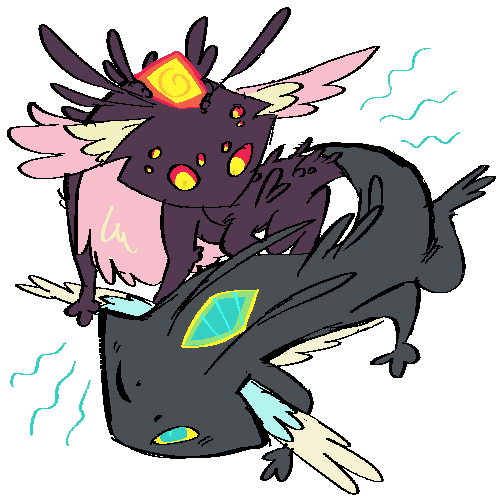[Cosmosdex] The Universal Encyclopedia
[Cosmosdex]
Csieverdel
Grays / Radioactive Flatworms
Csieverdel

Art by, marksman
- Strength-6
- Intelligence-6
- Charisma-4
- Endurance-2
- Agility-7
- Luck-1
Common Jobs: Actinobiologist, Nuclear Engineer, Spy, Actor
Likes: Blending in, Time well spent
Dislikes: Excessive cold, Bright light, Time wasted
Attack Method: They start by either running or laying low on the ground and hoping the attacker doesn't notice them. If that doesn't work (and there is no other choice), they attack by biting and wrapping around the attacker. If one is in such a dire situation where there is genuinely no other way to win, they will go supercritical and release high doses of radiation from their rad-organ.
Attributes
Homeplanet: CurievelLifespan: Depends on Isotope
Size: 0.33 ft tall, 10 ft long
Diet: Radiation, Meat, Fish
Bodytype: Multiped
Type: Amphibious Mollusk
Social Class: Lower Middle Class
Rarity: Rare
Common Traits
This character likes to stick with people in power and flatter them, or agree with everything they say.
This character is very good at improvisation, this means they can pull things off without instruction and can make up entire stories on the spot.
This character will always try to back down from a fight, though they will still act in self-defense if they don't have a choice. If forced into dangerous situations, they will suffer morale loss, and will be more inclined than most to abandon their crewmates.
Gods
They are rather unknowing of any gods, but are not inherently averse to worshipping any gods
Gods: None, Any
Original Creator: Chikaoofka
Physical Description
While physical traits of a csieverdel vary wildly based on whatever element they absorbed as a baby, there remains a common "base" for csieverdels. That base being an incredibly flat body with an arrow-tip of a head, small antennae on said head, wing-like "gills", a special "fur" on their undersides, and a rad-organ. The rad-organ is what makes a csieverdel a csieverdel, it's what collects the energy from the radioactive element they have. The element, appearing most often as a diamond-shaped rock of sorts on the base of their head, glows and was used to attract prey. If a csieverdel loses either the rad-organ or the radioactive thing, they will starve to death in around a week, no matter how much outside matter it eats. The special "fur" is not fur truly; while it is soft to the touch, it is used to reduce friction between the csieverdel and the ground, it feels the way anemones look. They have a small beak on their head, hidden by their "fur" which is used to eat whatever non-rad thing they need. It's very good at breaking shells open.
Csieverdels reproduce by budding, and baby csieverdels look like little slugs, only reaching 15 cm max until it finds a "suitable" isotope (ie, an isotope roughly the same size as the baby itself). They'd go on and eat it, and depending on the half-life/radioactivity of said isotope, they'd grow out and flat like normal. The differences arise from the radiation, mostly with little (not harmful) tumours, or antennae, or arms, among other mutations. The higher the radiation (ie. shorter the half-life) the more mutations one would get, but their lifespan would be shorter, and vice versa. The csieverdels' cells are extremely strong yet weak genetically, very mutable but very resistant to complete cell death.
Personality
Most csieverdels like to "go with the flow", and by extension are very conflict-avoidant. They like to blend in be that societal or physically, due to their previous endeavours as ambush predators before they were sapient. This also leads to a non-confrontational nature, as they don't want to upset others or get in some kind of fight. Despite that, though, they are incredibly adaptable to most any situation they may find themselves in. For instance, if a crewmate were to die suddenly, a csieverdel would not be phased, at most a little sad. Although whatever feelings they do feel wouldn't stop them from immediately searching for a way to fill the void caused by the loss of that crewmate. They seem to believe that dwelling on sadness or otherwise "poor" conditions of a situation is a waste of time.
Time, as a whole, is a rather important concept to the csieverdel. Rather, the concept of using one's time well. Anything that is seen to be a waste of time, is, well, a waste of time and as such a csieverdel will most likely simply not do that thing or get it done as soon as possible. This concept is often more important to those with "less time", or shorter half-lives, and less to those with longer half-lives. Those with shorter half-lives are also more often valued in society, and never leave their home planet.
History
Once a rather simple seabound species, nothing more than legless flat eel-like animals, very adapted to their warm-water oceans. Except, over the span of about 50 years, that ocean became warmer, warmer and warmer until it was unbearable. Unbearable to the point where the beings within said ocean threw themselves down a giant waterfall to try to escape this heat. Turns out, though, this heat was from the decay of these certain "rocks" that littered the crust (and innards) of their planet. Already mutable before, it wasn't long before these eels grew legs and grew to repurpose those "rocks" for their own. Soon after this repurposing, though, they grew more intelligent. Intelligent enough to form little societies at whatever layer they were living on. The history of these societies are rather bland, in the sense that there were no wars or trade issues, or much interaction at all. They had no interest in space-travel (mostly caused by a lack of knowledge that there was a "place" outside of their planet at all) until other, more space-inclined species found them.
Home Planet
The homeplanet of the csieverdel only seems to be nothing but an ocean planet on the surface, although with two giant sinkholes on opposite sides of the planet. The water on the surface is too warm for most things to thrive, leaving the ocean rife with nothing but bacteria who adapted fast enough to survive. The inside of this planet, though, is where whatever remained lives now. There's 3 "layers" to the planet, mirrored from a centre "barrier". The ones closest to the sinkholes being very warm and rocky, with cliff sides and gigantic "mountains" making a somewhat solid ground floor, although with giant chasms separating each cliff side. The second layer, directly below the rocky first, is a humid jungle that seems as if it grew upside-down from those cliffs, this layer is much more lush and green. Everything is "giant" there too, with giant mushrooms or giant lily-pads filled with water. It's a lot harder to fall from the 2nd to the 3rd layer as opposed to the 1st to the 2nd. Although, if someone were to find a way to the 3rd layer, they'd be met with a vast ocean with petrified lily-pad islands, and that ocean the leftover of the sinkholes' waterfalls, and the same ocean that filters back into the surface ocean. Despite that, though, this ocean is rather chilly (especially in comparison). The ceiling of the 3rd layer (or the underside of the 2nd, rather) is covered in brightly glowing worms and rocks, giving the appearance of a night sky. Ascending back to the 2nd or 1st layer is just as difficult as descending, with few entrance/exit tunnels.
Subspecies
Supercritical: Those who have used their radioactive element as a defence mechanism. Now highly radioactive, these csieverdels are bound to wander whatever world they're on endlessly until they starve (which is often really quickly, due to an inability to absorb the rads any longer). Their brains are essentially fried after going supercritical, leaving them mindless (not violent, though, just unresponsive).
Stable: Those who, as a baby, were unfortunate enough to absorb a stable element. Only growing to be 3 to 4 feet long, they are often not considered "true" csieverdels in the sense that they act like faunas. They often can't talk, and sometimes can't even understand speech. They are very food-aggressive, and are often better hunters than their radioactive counterparts. Sometimes, although not often, they're kept as pets (or hunting animals) by their more intelligent counterparts. The use of stable csieverdels as capture creatuers is not uncommon, as they are rather capable fighters as well. They can't go supercritical.
Star: Those who were lucky enough to absorb multiple elements (or multiple copies of an element) as a baby. Despite the added weight of these extra elements (and by extension rad-organs) they are usually just as fast/strong as normal csieverdels, and are often even more intelligent. They both live and are longer than the average cseiverdel (being able to reach ~15 feet as a loose minimum). Their element glows brighter than those same csieverdels, leading to them being named the Stars of Curievel. That being said, though, they are incredibly rare due to attempts to absorb more than one radioactive isotope usually just leads to the csieverdels' death, due to the lack of a second rad-organ. The extent to which a csieverdel is more "exceptional" is proportionate to the amount of extra elements, and what exactly those elements are.
Special
Rad-organ: They have a specialised organ that both absorbs and repurposes nuclear energy to power themselves. It prevents the csieverdel itself from being dangerous towards other people. This organ also absorbs outside radiation, although it can't be used by the csieverdel for energy. The organ itself is just a thin film over the element, and can be "popped", but if it is popped the csieverdel immediately goes supercritical.
Trivia
• They do not feel pain and have a poor sense of touch. Their perception of temperature is also reduced, as well. They also have a high light sensitivity.
• Csieverdels, whose radiation is not harmful when they are alive, once they die their corpses often become incredibly dangerous to be around (for all non-unstable csieverdels). Their meat similarly is nigh-completely inedible, no matter the circumstances.
• Cseiverdel names are usually very short and reflect their element, for instance "Ac" or "K". Many space-faring csieverdels change this to a longer version, such as "Actino" or "Karmen".
Image Gallery
No art currently, maybe you can help.
